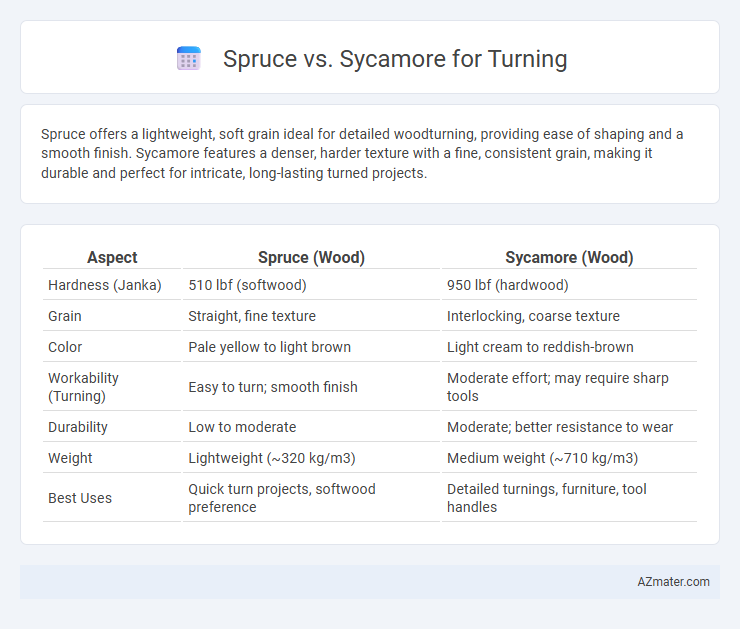Spruce offers a lightweight, soft grain ideal for detailed woodturning, providing ease of shaping and a smooth finish. Sycamore features a denser, harder texture with a fine, consistent grain, making it durable and perfect for intricate, long-lasting turned projects.
Table of Comparison
| Aspect | Spruce (Wood) | Sycamore (Wood) |
|---|---|---|
| Hardness (Janka) | 510 lbf (softwood) | 950 lbf (hardwood) |
| Grain | Straight, fine texture | Interlocking, coarse texture |
| Color | Pale yellow to light brown | Light cream to reddish-brown |
| Workability (Turning) | Easy to turn; smooth finish | Moderate effort; may require sharp tools |
| Durability | Low to moderate | Moderate; better resistance to wear |
| Weight | Lightweight (~320 kg/m3) | Medium weight (~710 kg/m3) |
| Best Uses | Quick turn projects, softwood preference | Detailed turnings, furniture, tool handles |
Introduction to Spruce and Sycamore for Woodturning
Spruce offers a lightweight, softwood option with fine, even grain, making it ideal for delicate woodturning projects requiring ease of shaping. Sycamore, a hardwood with a dense, interlocking grain, provides durability and a smooth finish, favored for intricate, durable turned pieces. Both woods exhibit distinct characteristics, influencing tool selection and finishing techniques in woodturning craftsmanship.
Botanical Differences: Spruce vs Sycamore
Spruce (genus Picea) is a coniferous evergreen tree characterized by needle-like leaves and produces cones, belonging to the Pinaceae family, whereas Sycamore (genus Platanus) is a deciduous hardwood tree with broad, lobed leaves and distinctive exfoliating bark, classified within the Platanaceae family. Spruce wood features a relatively uniform grain with a softer texture, ideal for detailed turning projects that require fine finishes, while Sycamore wood exhibits a coarser, interlocked grain pattern, providing durability and a unique figured appearance when turned. Botanical differences such as leaf type, wood density, and grain structure directly influence the suitability of each species for woodturning applications, with spruce favored for lightweight, smooth carvings and sycamore preferred for robust, decorative pieces.
Workability: Turning Ease and Techniques
Spruce offers excellent turning ease due to its straight grain and soft texture, enabling smooth cuts and fine detailing with minimal tool resistance. Sycamore, while slightly harder and denser, provides good workability but demands sharper tools and slower feed rates to prevent grain tearing and achieve clean finishes. Mastery of spindle or bowl gouges is recommended for spruce, while sycamore benefits from controlled cuts and occasional sanding for optimal surface quality in woodturning projects.
Grain Patterns and Aesthetic Appeal
Spruce features a straight, uniform grain pattern that creates a clean and consistent aesthetic, making it ideal for turning projects that require smooth finishes and subtle textures. Sycamore displays a more varied grain with intricate flame-like patterns and occasional burl clusters, offering a visually striking and dynamic appearance prized in decorative turning. The choice between spruce and sycamore depends on whether the desired aesthetic emphasizes simplicity and uniformity or complexity and visual impact.
Hardness and Durability Comparison
Spruce wood typically has a Janka hardness rating of around 350, making it softer and less resistant to dents compared to sycamore, which has a hardness of approximately 900. Sycamore's higher density enhances its durability, providing better wear resistance and structural integrity for turning projects. When choosing between the two, sycamore offers superior hardness and longevity, ideal for items requiring more robust performance.
Finishing Qualities: Staining, Polishing, and Sealing
Spruce features a fine, even grain that accepts stains uniformly, resulting in a smooth, consistent finish ideal for staining and polishing. Sycamore's open grain structure can cause uneven stain absorption, requiring pre-sealing techniques for a more polished look and enhanced sealing durability. Both woods respond well to sanding, but Sycamore typically benefits from additional sealing layers to achieve a high-gloss finish and protect the wood surface during use.
Availability and Cost Factors
Spruce is widely available and generally more affordable than sycamore, making it a preferred choice for woodturning projects with budget constraints. Sycamore, while less common and possibly harder to source, offers unique grain patterns that justify its higher cost for specialty pieces. The cost difference between these woods reflects their availability, with spruce being a cost-effective option for beginners and sycamore serving as a premium material for experienced turners seeking distinct aesthetics.
Common Projects: Best Uses for Each Wood
Spruce offers lightweight properties and fine grain, making it ideal for detailed, delicate turnings in instrument-making and small decorative items. Sycamore's durability and attractive grain pattern suit it for robust, functional projects like bowls, utensils, and furniture components that require both strength and aesthetic appeal. Understanding the wood's grain structure and hardness guides artisans to select spruce for precision work and sycamore for pieces needing resilience and visual texture.
Environmental Impact and Sustainability
Spruce turning projects benefit from the wood's rapid growth rate, making it a more sustainable choice due to its carbon sequestration potential and minimal habitat disruption. Sycamore, while slower growing, is often sourced from managed forests where sustainable harvesting practices preserve ecosystem balance and support biodiversity. Both woods offer eco-friendly options, but spruce typically has a lower environmental footprint due to its faster replenishment cycle and efficient resource use.
Expert Recommendations: Choosing Spruce or Sycamore for Turning
Spruce is favored for turning projects requiring lightweight, stable wood with fine, even grain, making it ideal for intricate details and delicate finishes. Sycamore offers a harder, denser texture with a smooth grain that provides durability and a refined appearance, suitable for items demanding strength and a polished look. Experts recommend selecting spruce for ease of shaping and a clean finish, while sycamore is preferred when resilience and a fine satin texture are critical for the turning piece.

Infographic: Spruce vs Sycamore for Turning
 azmater.com
azmater.com